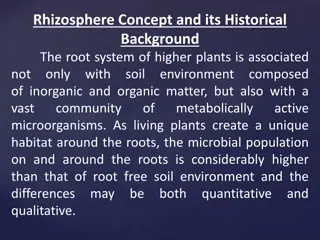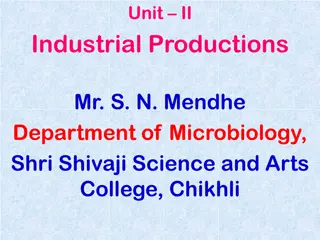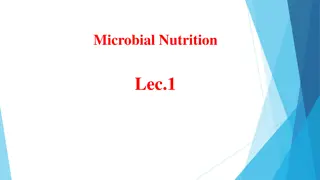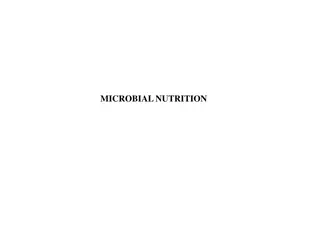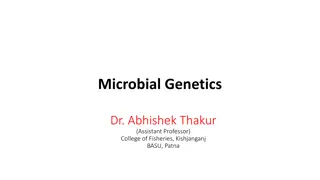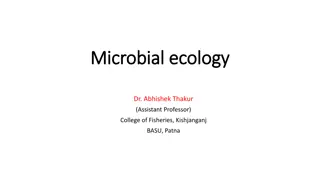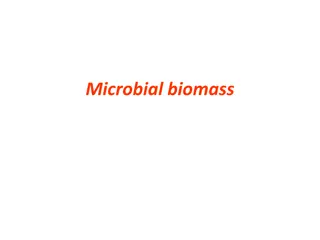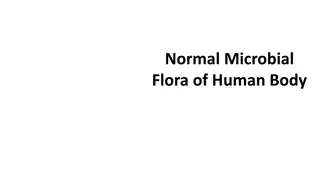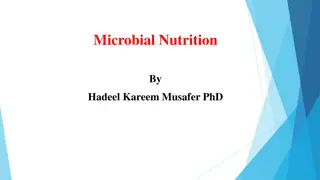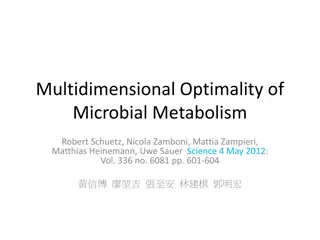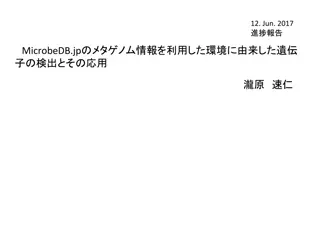Improving Microbial Productivity and Characteristics for Industrial Applications
Efforts to enhance the productivity of natural isolates for commercial products involve genetic modifications through mutation, genetic recombination, and genetic engineering techniques. Desired characteristics include genetic stability, efficient production, versatility in carbon sources, and ease of genetic manipulation. Strain improvement is achieved through natural recombination or mutagenesis, followed by screening for desired traits. The inheritance of altered DNA leads to potential advancements in industrial fermentation processes.
Download Presentation

Please find below an Image/Link to download the presentation.
The content on the website is provided AS IS for your information and personal use only. It may not be sold, licensed, or shared on other websites without obtaining consent from the author.If you encounter any issues during the download, it is possible that the publisher has removed the file from their server.
You are allowed to download the files provided on this website for personal or commercial use, subject to the condition that they are used lawfully. All files are the property of their respective owners.
The content on the website is provided AS IS for your information and personal use only. It may not be sold, licensed, or shared on other websites without obtaining consent from the author.
E N D
Presentation Transcript
Natural isolates usually produce commercially important products in very low concentrations and therefore every attempt is made to increase the productivity of the chosen organism. In nature, metabolism is carefully controlled to avoid wasteful expenditure of energy and the accumulation of intermediates and enzymes needed for their biosynthesis. The potential productivity of the organism is controlled by its genome and, therefore, the genome must be modified to increase the potential yield. Genetic modification may be achieved by selecting natural variants, by selecting induced mutants and by selecting recombinants.
Irrespective of the origins of an industrial microorganism, it should ideally exhibit: Genetic stability Efficient production of the target product, whose route of biosynthesis should preferably be well characterized Limited or no need for vitamins and additional growth factors Utilization of a wide range of low-cost and readily available carbon sources Amenability to genetic manipulation Safety, non-pathogenicity and should not produce toxic agents, unless this is the target product Ready harvesting from the fermentation Ready breakage, if the target product is intracellular Production of limited byproducts to ease subsequent purification problems.
In many cases strain improvement has been accomplished using natural methods of genetic recombination, which bring together genetic elements from two different genomes into one unit to form new genotypes. An alternative strategy is via mutagenesis. Those recombinants and mutants are then subjected to screening and selection to obtain strains whose characteristics are more specifically suited to the industrial fermentation process. However, such strains are unlikely to survive
Several procedures are employed to improve microbial strains. All bring about changes in DNA sequence. These changes are achieved by mutation, genetic recombination, or the modern DNA splicing techniques of genetic engineering. Each procedure has distinct advantages. In some cases, a combination of one or more techniques is employed to attain maximum strain improvement.
Microbes, generation after generation, generally inherit identical characteristics as their parents. However, when changes occur in the DNA, they too are passed on to daughter cells and inherited in future generations. This permanent alteration of one or more nucleotides at a specific site along the DNA strand is called a genetic mutation.
On the basis of the method of screening and selection chosen, there are basically two methods of improving microbial strains through random mutation: (1) random selection and (2) rationalized selection.
Random mutagenesis and selection is also referred to as the classic approach or non-recombinant strain improvement procedure. After inducing mutations in the culture, the survivors from the population are randomly picked and tested for their ability to produce the metabolite of interest. it offers a significant advantage over the genetic engineering route alone by yielding gains with minimal start-up and sustaining such gains over years despite a lack of scientific knowledge of the biosynthetic pathway, physiology, or genetics of the producing microbe. One drawback to the random selection approach is that it relies on non-targeted, non-specific gene mutations, so many strains need to be screened to isolate the improved mutant in the mixed population.
This process of strain improvement involves repeated applications of three basic principles: random selection and screening from the surviving population of improved strains by Small scale model fermentation assaying of mutagenesis of the population to induce genetic variability fermentation broth/agar for products and scoring for improved strains
Although the procedure is repetitive and labor intensive, this empirical approach has a long history of success and has given dramatic increases in titer improvement, as best exemplified by the improvements achieved for penicillin production in which titers over 50 g/liter are reported a 4000-fold improvement over the original parent strain. To increase the efficiency of random selection, ways by which the key steps in the process can drive the throughput higher without adding labor are typically sought. In some instances high throughput screens have been automated with robotics technology.
An alternate approach to random screening requires a basic understanding of product formation and the fermentation pathway; this can be acquired through radioisotope feeding studies and isolation of mutants blocked in various pathways. These observations can shed light on the metabolic checkpoints, and suggest ways to isolate specific mutants. For example, environmental conditions (pH, temperature, aeration) can be manipulated, or chemicals can be incorporated in the culture media to select mutants with desired traits. Rationalized selection for strain improvement does not generally require a sophisticated understanding of molecular biology to manipulate environmental or cultural conditions.
It can be done by Optimizing environmental condition Optimizing nutrition of micro-organism 1. Methods not involving foreign DNA- mutagenesis
The best example of the modification of the permeability of a micro-organism is provided by the glutamic acid fermentation. Kinoshita et al. (l957a) isolated a biotin- requiring, glutamate-producing organism, subsequently named Corynebacterium glutamicum, the permeability of which could be modified by the level of biotin.
Given figure is a branched pathway controlled by the concerted inhibition of the first enzyme in the pathway by the combined effects of E and G. The mutant illustrated is auxotrophic for E due to an inability to convert C to D, resulting in the removal of the concerted control of the first enzyme. Provided that E is included in the medium at a level sufficient to allow growth but insufficient to cause inhibition then C will be accumulated due to the control of the end product G on the conversion of C to F.
Isolating strains relaxed in regulation can usually be accomplished by selecting strains desensitized to feedback inhibition (enzyme activities) or feedback repression (enzyme synthesis) involved in the pathway. The use of auxotrophic mutant is useless when the end product controls its own synthesis independently.
In many microbes, the end products of metabolism, when accumulated in the microbial cell, inhibit the enzyme activities of many pathways. The end product causes conformational changes by binding to a specific (allosteric) site on the enzyme, and inhibits activity. The binding is usually noncompetitive. Mutation in the structural gene, however, can alter the enzyme binding site and prevent these inhibitory effects. Studying the interaction of various analogs of end products and their resistance, improved strains can be selected that lack feedback inhibition and thus overproduce metabolites of interest.
Here intermediates, products of catabolism (derived from breakdown of compounds containing carbon, nitrogen, or phosphorus), or end products regulate the amount of biosynthetic enzymes synthesized and, therefore, the amount of final product formed. However, mutations at the operator site or other regulatory sites on the gene relieve such end-product repression and allow overproduction of the biosynthetic enzyme.
Protoplast fusion Fusing two closely related protoplasts (cells whose walls are removed by enzyme treatment) is a versatile technique that combines the entire genetic material from two cells to generate recombinants with desired traits that cannot be obtained through a single mutation. Transformation Transformation is the process involving the direct uptake of purified, exogenously supplied DNA by recipient cells or protoplasts. Conjugation Conjugation introduces mutational changes in microbes through unidirectional transfer of genetic material from one strain to the other; it is mediated by plasmid sex factors. Protoplast fusion Transformation Conjugation
In vitro By employing restriction endonucleases and ligases, investigators can cut and splice DNA at specific sites. Isolate the desired gene (DNA fragment) from the donor cells. Isolate the vector (a plasmid or a phage). Cleave the vector, align the donor DNA with the vector, and insert the gene into the vector. Introduce the new plasmid into the host cell by transformation or, if a viral vector is used, by infection. Select the new recombinant strains that express the desired characteristics. In vitro recombinant DNA technology recombinant DNA technology
So far the mutations and the modifications of the strains discussed have been randomly directed at the level of the genome of the culture. The application of recombinant technology and the use of synthetic DNA now make it possible to induce specific mutations in specific genes. This procedure of carrying out mutagenesis at a targeted site in the genome is called site-directed mutagenesis. It involves the isolation of the DNA of the specific gene and the determination of the DNA sequence. It is then possible to construct a modified version of this gene in which specific bases or a series of bases are changed. The modified DNA can now be reinserted into the recipient cells and the mutants selected.
Increase the productivities Regulating the activity of the enzymes Introducing the new genetic properties into the organism by recombinant DNA technology/Genetic engineering.
Rapid growth Genetic stability Non-toxicity to humans Ability to use cheaper substrates Elimination of production of compounds that may interfere with downstream processing. To improve the use of carbon and nitrogen sources. Reduction of cultivation cost. Shorter fermentation time.




